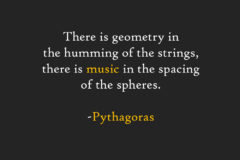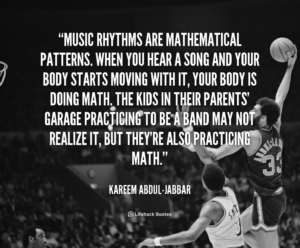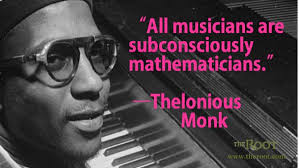Math teachers have often noticed that students who are good in math have studied, or are studying, music. In the past, it was assumed that the kind of discipline necessary to excel in playing a musical instrument would extend to other academic areas, leading to  excellence in those areas as well. But some researchers looked at the math-music relationship and wondered if something other than discipline may be involved.
excellence in those areas as well. But some researchers looked at the math-music relationship and wondered if something other than discipline may be involved.
Since the time of the ancient Greeks, people have been fascinated with the relationship between music and mathematics. Pythagoras (died 500 B.C.) is considered by some to be the founder of both math and music – famous for his theorum on triangles in mathematics, but also for developing the concept of intervals in music (link from Physics of Music course, George Gibson, University of Connecticut).
The relationship between math and music has been written about by philosophers, poets, scientists, musicians, mathematicians, and others. Currently, there are dozens of books in print on the subject, ranging from historical perspectives to explorations of acoustical, theoretical, physical, or analytical relationships.
The American Mathematical Society has a web page devoted to Mathematics & Music – with several videos, podcasts and articles exploring the connections between the two, including a link to a TedEd talk below, which uses Beethoven’s Moonlight Sonata (C# minor, Op. 27, No. 2) “to illustrate the way Beethoven was able to convey emotion and creativity using the certainty of mathematics.”
Now we know that Beethoven was not thinking about math when he composed the Moonlight Sonata. And he was not completely deaf, as the video implies. At the time he composed that sonata, he was suffering from severe tinnitus and had lost more than half of his hearing, but he was always able to hear music in his mind even if he could not physically hear it – he wouldn’t have needed to rely on math to compose. Nevertheless, the video is a fascinating look at how the sound of this iconic piece of music can be described mathematically.
So is there a connection between high achievement in music and in mathematics? There have been several correlational studies over the past 20 years. To mention just a couple: a 2006 study from the Center for Arts Education Research at Columbia University showed that over a period of six years, students in five elementary schools who were studying violin consistently had larger improvements in standardized test scores in mathematics than control groups at the same grade level.
And a study funded by the NAMM Foundation (National Association of Music Merchants) with support from the Grammy Foundation and the U.S. Department of Education, also in 2006, compared students in top-quality school music programs in four areas of the country (West, Midwest, East, South) with students in lesser-quality music programs in those same geographical areas.
At the elementary school level, students in the top-quality programs scored 20% better in mathematics than students in the lesser-quality programs. At the middle school level, students in the top music programs scored 17% higher in mathematics than children in schools without a music program. (Synopsis; Access to full article) And for those of you who may question how top-quality music programs were determined, the journal article answers that question.
Data from 1999 – 2013 showed that students who took four years of high school arts and music classes had scores in the Critical Reading and Mathematics portions of the SAT that ranged from 80 to 103 points higher than students who had half a year or less of arts and music courses.
In the various correlational studies, researchers sometimes refer to arithmetic, sometimes mathematics. Arithmetic is usually used when speaking about very young children, and mathematics when the studies involve older students. It depends on what is being tested or used for evaluation. Arithmetic is the study of numbers and basic addition, subtraction, multiplication and division. Mathematics studies the relationships among numbers, shapes and quantities; it includes arithmetic, geometry, calculus, trigonometry, algebra – and uses symbols,  signs, theorems, and formulas. As one mathematician put it, arithmetic is simple calculation while mathematics is cognition; arithmetic is about numbers, mathematics about theory.
signs, theorems, and formulas. As one mathematician put it, arithmetic is simple calculation while mathematics is cognition; arithmetic is about numbers, mathematics about theory.
Basic elements of music, such as pitch, rhythm, tempo, form, and meter can all be related to measurement of time and frequency, which are mathematical concepts. For example, musical intervals are mathematical ratios; meter signatures are written as fractions. The Mathematics & Music page on the American Mathematical society website has multiple sources for looking at the connections.
And those connections may be reflected in our brains. Gottfried Schlaug, Professor of Neurology and Director of the Music and Neuroimaging Laboratory at Beth Israel Deaconess Medical Center and Harvard Medical School, suggests that neuroplasticity that occurs in brain regions involved in musical processing “may have an effect on mathematical performance because of shared neural resources involved in the mental manipulation of symbolic representation.”
According to several researchers, those “shared neural resources” are the neural networks involved in spatial-temporal reasoning, which is crucial to both music and mathematics.
Spatial-temporal reasoning (sometimes shortened to ST reasoning) is the ability to visualize spatial patterns and mentally move them in space and time. People who are good at spatial- temporal reasoning are good at seeing how things fit together and how they can be manipulated. This ability is important for conceptualizing solutions to multi-step problems, and it’s used in areas such as engineering, mathematics, architecture, chess, physics, and music.
temporal reasoning are good at seeing how things fit together and how they can be manipulated. This ability is important for conceptualizing solutions to multi-step problems, and it’s used in areas such as engineering, mathematics, architecture, chess, physics, and music.
Musicians use spatial-temporal reasoning all the time, without knowing what it is. We deal with patterns in music, patterns that are transposed or inverted in time and space, but the relationships between notes remain the same. Moving through the circle of fifths to play scales or arpeggios in all keys involves spatial-temporal processing. Visualizing how a chord pattern in one octave will look in another is spatial-temporal ability – as is understanding meter signatures, subdivisions of a beat, a piece unfolding within a certain period of time. Composers create scores for any number of instruments, visualizing how all of the parts fit together, and conductors do the same when they are learning the score for performance – spatial-temporal processing.
And that brings us back to the study by Frances Rauscher and colleagues in 1993 that led to the media creation of the “Mozart Effect.”
I’ve written about this study previously in the post, Music makes you smarter – or maybe not. But to recap, Rauscher’s study demonstrated that, after 10 minutes of listening to either Mozart’s Sonata for 2 pianos in D major, K488, listening to a relaxation tape, or silence, those students who had listened to Mozart scored 8 -9 points higher on an IQ test that measured spatial-temporal reasoning. Rauscher made absolutely no claims about general IQ – only about spatial-temporal reasoning, and noted that the effect didn’t last very long, only about 15 minutes. Nevertheless, the media loved the idea that listening to Mozart could make you smarter, and the Mozart Effect was born – and persists today.
Rauscher realized early on that it wasn’t listening that would lead to long-term strengthening of spatial-temporal reasoning, but actually learning to play and studying a musical instrument. She has been involved in several studies since the first one in 1993, as have other researchers, and the results show that studying an instrument improves spatial-temporal reasoning; some of these studies test mathematics ability rather than ST reasoning and find a correlation between music and mathematics achievement. But the trajectory seems to be that studying music improves spatial-temporal reasoning, which is used extensively in mathematics. Therefore, learning and studying a musical instrument can have a beneficial effect on math learning.
None of the scientists or educators involved in this research are saying that one should study music to be better at math. That’s not why most of us want to study music. But many do stress that there are educational and cognitive advantages to studying music and that it shouldn’t so readily be dismissed from the curriculum. If the brain is using shared networks for certain kinds of processing in math and music, then studying music can only be a benefit for learning math.
Musical form is close to mathematics — not perhaps to mathematics itself, but certainly to something like mathematical thinking and relationship. — composer Igor Stravinsky
One response to “Music and math: Why study music, part II”
I’ve written many ideas about the relationship between math and music: see my web site below where you can download my entire book free. Beethoven’s 5th symphony is a mathematical exposition of group theory, written 30 years before mathematicians and physicists recognized the practical value of group theory applicable to subjects such as quantum mechanics and semiconductor technology (see section 67 of my book). The chromatic scale is purely logarithmic, the human ear can adapt to logarithms readily, and I propose that the brain can map this log function within the brain, which explains relative pitch, harmonic intervals, why humans like harmony, and why music follows chord progressions, etc.. The piano is just a large slide rule, and when you are playing it, you are performing complex mathematical operations on this slide rule that the brain can interpret using the log function.